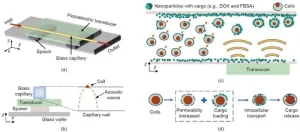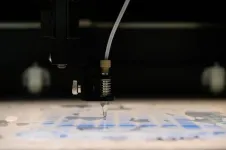(Press-News.org) Up to 10% of cancers are caused by genes that can be easily detected by commercially available tests. These include such common cancers as cancer of the breast, ovary, colon, stomach, uterus and pancreas.
“We don’t routinely screen for cancer susceptibility genes in primary-care settings because genetic testing is often considered too complicated and primary care doctors already have so many things they need to address,” noted lead author Dr. Elizabeth Swisher, a UW Medicine gynecological oncologist. "But it is an opportunity lost.”
In the JAMA Network Open study published today, Swisher and colleagues assessed two ways that primary-care practices could assess patients’ hereditary cancer risks and deliver testing to those identified as higher risk.
Patients with a family history of cancer are at the highest risk of carrying these genes. Even though they are an ideal group for testing, screening of these patients is rarely done as part of routine primary care, when it’s most likely to detect the risk before a cancer has developed, Swisher said.
In the study, one approach involved asking patients when they came to the clinic, or before a virtual visit, to fill out a questionnaire before they saw their primary-care provider. This was called the point-of-care approach.
The second approach involved sending a series of letters or emails to patients inviting them to fill out the questionnaire online from home. This was called the direct patient engagement approach.
The questionnaires asked about the patients' cancer history and that of their first-degree relatives — parents, siblings, and offspring — and second-degree relatives such as grandparents, aunt and uncles, and nieces and nephews. The questionnaire also asked about relevant ethnic information, such as Ashkenazi Jewish ancestry, which is associated with a genetic risk of several cancers, including cancers of the breast, prostate, colon and pancreas.
Patients whose completed assessment suggested they might carry a cancer-susceptibility gene were offered a test that screened for 29 such genes.
The saliva-sample test was offered for free and could be administered at home. All patients who were found to have cancer-risk gene variants were provided genetic counseling.
“The goal was to bypass the primary-care physician up until there was a positive test and then provide the physician with a care plan for each patient,” Swisher said.
The study was conducted in 12 primary-care clinics run by two different health care systems. Six were in Washington state, run by MultiCare, and six were in Montana and Wyoming, run by the Billings Clinic. The MultiCare clinics primarily serve a mixed ethnic and racial urban population. The Billings Clinic primarily serves a rural white population.
The clinics were randomly assigned to use one or the other approach. During the study period, 95,623 patients were seen in the 12 clinics. Of these, 18,030 were approached during their visit in-clinic and 41,558 were sent email or letters.
The researchers found that the point-of-care approach resulted in a higher proportion of patients (19.1%) completing the risk assessment than was the case in the direct patient engagement group (8/7%), relative to the total clinic population.
But among those whose assessment indicated they were eligible for testing, a larger proportion of the direct engagement group got tested: 44.7% compared with 24.7% of the point-of-care group.
Swisher speculated the respondents in the direct engagement group may have already had concerns about their family genetic history. Although fewer from this group responded, those who did were more likely to test positive (6.6%) than were people in the point-of-care group (3.8%).
“Both strategies had some utility,” Swisher concluded, “but we need to develop ways to improve uptake of testing and further reduce barriers to the testing process.”
END
Effort seeks to increase cancer-gene testing in primary care
Detecting cancer-risk genes early can be lifesaving, but most testing is still being done after cancer has been diagnosed
2025-03-07
ELSE PRESS RELEASES FROM THIS DATE:
Acoustofluidics-based method facilitates intracellular nanoparticle delivery
2025-03-07
A recent study published in Engineering presents an innovative acoustofluidics-based approach for intracellular nanoparticle delivery. This method offers a new way to transport various functional nanomaterials into different cell types, potentially revolutionizing therapeutic applications and biophysical studies.
The efficient delivery of biomolecular cargos into cells is crucial for biomedical research, including gene therapies and drug delivery. However, traditional delivery methods such as endocytosis of nano-vectors, microinjection, and electroporation have limitations. They may require time-consuming processes, complex operations, or expensive equipment. ...
Sulfur bacteria team up to break down organic substances in the seabed
2025-03-07
Sulfate-reducing bacteria break down a large proportion of the organic carbon in oxygen-free zones of the Earth, and in the seabed in particular. Among these important microbes, the Desulfobacteraceae family of bacteria stands out because its members are able to break down a wide variety of compounds – including some that are poorly degradable – to their end product, carbon dioxide (CO2).
A team of researchers led by Dr Lars Wöhlbrand and Prof. Dr Ralf Rabus from the University of Oldenburg, Germany, has investigated the role ...
Stretching spider silk makes it stronger
2025-03-07
When spiders spin their webs, they use their hind legs to pull silk threads from their spinnerets. This pulling action doesn’t just help the spider release the silk, it’s also a crucial step in strengthening the silk fibers for a more durable web.
In a new study, Northwestern University researchers have discovered why the role of stretching is so important. By simulating spider silk in a computational model, the team discovered the stretching process aligns the protein chains within the fibers and increases the number of bonds between those ...
Earth's orbital rhythms link timing of giant eruptions and climate change
2025-03-07
On ten thousand to million years time scales, climate dynamics on the Earth’s surface are driven by both external and internal processes. Earth`s interior provides heat from radioactive decay and chemical compounds by volcanic degassing, such as sulfur dioxide (SO2) and carbon dioxide (CO2). Quasiperiodic changes in Earth’s orbit around the sun regulate the amount of incoming solar radiation on the planet’s surface as well as its distribution across latitudes, affecting the length and intensity ...
Ammonia build-up kills liver cells but can be prevented using existing drug
2025-03-07
High levels of ammonia kill liver cells by damaging the mitochondria that power the cells. But this can be prevented using an existing drug due to start clinical trials, finds a new study in mice led by researchers from UCL.
The study, published in Science Advances, is the first to observe that build-up of ammonia (hyperammonaemia) can harm liver cells and describe how this damage occurs in mouse models that are clinically relevant for humans.
Hyperammonaemia is known to cause brain dysfunction in those with liver disease, ...
New technical guidelines pave the way for widespread adoption of methane-reducing feed additives in dairy and livestock
2025-03-07
Philadelphia, March 7, 2025 – After many decades of research, the dairy sector has a significant body of peer-reviewed research showing that feed additives can effectively reduce methane, the greenhouse gas that makes up most of dairy’s environmental footprint. Yet the practical use of this knowledge on farms—as well as general awareness around additive effectiveness and safety—is still gaining momentum. At this critical point in the dairy sector’s pathway to a net-zero future, the Journal of Dairy Science, the leading general dairy research journal from ...
Eradivir announces Phase 2 human challenge study of EV25 in healthy adults infected with influenza
2025-03-07
WEST LAFAYETTE, Ind. — Eradivir, a clinical-stage small molecule immunotherapy biotech company, announced it has begun a Phase 2 challenge study with its antiviral therapeutic, EV25. The study will provide safety and efficacy data gathered from otherwise healthy participants infected with influenza then later treated with EV25.
EV25 was built on a platform created in Philip Low’s lab. Low is the Presidential Scholar for Drug Discovery and the Ralph C. Corley Distinguished Professor of Chemistry in Purdue University’s College of Science. Low is Eradivir’s chief scientific officer and on its board of directors.
The European Medicines ...
New study finds that tooth size in Otaria byronia reflects historical shifts in population abundance
2025-03-07
Puerto Madryn, Argentina – A new study published in PeerJ Life and Environment reveals that the teeth of South American sea lions (Otaria byronia) hold valuable clues about past population dynamics. Researchers from the Instituto de Biología de Organismos Marinos, the Centro para el Estudio de Sistemas Marinos, and the Universidad Nacional de la Patagonia San Juan Bosco analysed changes intooth size and growth layer groups (GLGs) over the ...
nTIDE March 2025 Jobs Report: Employment rate for people with disabilities holds steady at new plateau, despite February dip
2025-03-07
East Hanover, NJ – March 7, 2024 – The employment rate for people with disabilities saw a slight dip in February but continued to fluctuate around a steady plateau of approximately 37.5%. While these dips can trigger speculation about broader policy implications, nTIDE experts cautioned that it is premature to attribute changes to recent shifts in federal employment policies. The employment-to-population ratio for people with disabilities remained stable. nTIDE is issued by Kessler Foundation and the ...
Breakthrough cardiac regeneration research offers hope for the treatment of ischemic heart failure
2025-03-07
Researchers in the Michael E. DeBakey Department of Surgery at Baylor College of Medicine, the QIMR Berghofer Medical Research Institute in Brisbane, Australia, and collaborating institutions report a groundbreaking discovery in cardiac regeneration that offers new hope for the treatment of ischemic heart failure. Published in npj Regenerative Medicine, the study reveals a novel approach to promoting cardiomyocyte proliferation.
“When the heart cannot replace injured cardiomyocytes with healthy ones, it becomes progressively ...
LAST 30 PRESS RELEASES:
First Editorial of 2026: Resisting AI slop
Joint ground- and space-based observations reveal Saturn-mass rogue planet
Inheritable genetic variant offers protection against blood cancer risk and progression
Pigs settled Pacific islands alongside early human voyagers
A Coral reef’s daily pulse reshapes microbes in surrounding waters
EAST Tokamak experiments exceed plasma density limit, offering new approach to fusion ignition
Groundbreaking discovery reveals Africa’s oldest cremation pyre and complex ritual practices
First breathing ‘lung-on-chip’ developed using genetically identical cells
How people moved pigs across the Pacific
Interaction of climate change and human activity and its impact on plant diversity in Qinghai-Tibet plateau
From addressing uncertainty to national strategy: an interpretation of Professor Lim Siong Guan’s views
Clinical trials on AI language model use in digestive healthcare
Scientists improve robotic visual–inertial trajectory localization accuracy using cross-modal interaction and selection techniques
Correlation between cancer cachexia and immune-related adverse events in HCC
Human adipose tissue: a new source for functional organoids
Metro lines double as freight highways during off-peak hours, Beijing study shows
Biomedical functions and applications of nanomaterials in tumor diagnosis and treatment: perspectives from ophthalmic oncology
3D imaging unveils how passivation improves perovskite solar cell performance
Enriching framework Al sites in 8-membered rings of Cu-SSZ-39 zeolite to enhance low-temperature ammonia selective catalytic reduction performance
AI-powered RNA drug development: a new frontier in therapeutics
Decoupling the HOR enhancement on PtRu: Dynamically matching interfacial water to reaction coordinates
Sulfur isn’t poisonous when it synergistically acts with phosphine in olefins hydroformylation
URI researchers uncover molecular mechanisms behind speciation in corals
Chitin based carbon aerogel offers a cleaner way to store thermal energy
Tracing hidden sources of nitrate pollution in rapidly changing rural urban landscapes
Viruses on plastic pollution may quietly accelerate the spread of antibiotic resistance
Three UH Rainbow Babies & Children’s faculty elected to prestigious American Pediatric Society
Tunnel resilience models unveiled to aid post-earthquake recovery
Satellite communication systems: the future of 5G/6G connectivity
Space computing power networks: a new frontier for satellite technologies
[Press-News.org] Effort seeks to increase cancer-gene testing in primary careDetecting cancer-risk genes early can be lifesaving, but most testing is still being done after cancer has been diagnosed






